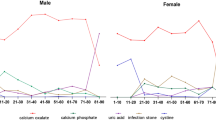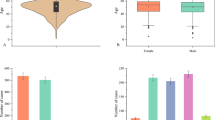Abstract
Purpose
To analyze urinary stone composition in Israel and assess the effects of key demographic parameters (gender, age, socioeconomic status, ethnicity, medical history and geographic region) on stone composition.
Methods
A retrospective review was conducted of stone analysis of 10,633 patients from an HMO Israeli database analyzed by a central laboratory from 2014 to 2019 and subjected to Fourier-transform infrared spectroscopy. Associations between stone composition and different demographic parameters were determined using the Chi-square test.
Results
Calcium oxalate (CaOx) monohydrate accounted for 51.9% of the stones. Of the total sample, 5776 stones had one single component (54%), whereas 4857 (46%) had mixed components. Men had a higher frequency of CaOx stones (89.6% vs. 85.6%), whereas women had a higher frequency of calcium phosphate, infection, and cystine stones (27.2%, 17.7%, and 0.9% vs. 17.2%, 7.5%, and 0.5%, respectively). Cystine stones were more abundant in Arabs (1.2% vs. 0.5% in the Jewish population). Lower socioeconomic status was associated with a higher prevalence of calcium phosphate, uric acid, and infection stones and a lower prevalence of CaOx stones. Uric acid stones were associated with medical conditions such as diabetes, hypertension, ischemic heart disease, and obesity (28.3%, 24.9%, 25.7%, and 22.6% vs. 9.6%, 8.4%, 12.3%, and 10.3%, respectively).
Conclusions
Stone types were highly influenced by patients’ demographics. COM was the most common stone component in either pure or complex form. UA stone prevalence was found to increase with age and was associated with medical conditions such as diabetes, hypertension, ischemic heart disease, and obesity.

Similar content being viewed by others
Data availability
Data supporting this study are not publicly available due to ethical reasons.
References
Scales CD, Smith AC, Hanley JM, Saigal CS (2012) Prevalence of kidney stones in the United States. Eur J Surg Oncol 62:160–165. https://doi.org/10.1016/j.eururo.2012.03.052
Romero V, Akpinar H, Assimos DG (2010) Kidney stones: a global picture of prevalence, incidence, and associated risk factors. Rev Urol 12(2):86–96. https://doi.org/10.3909/riu0459
Wilbert D, Ko K (2003) European urology study on the prevalence and incidence of urolithiasis in Germany comparing the years 1979 vs.2000. Eur Urol 44:709–713. https://doi.org/10.1016/S0302-2838(03)00415-9
Moe OW (2006) Kidney stones : pathophysiology and medical management. Lancet 367(9507):333–344. https://doi.org/10.1016/S0140-6736(06)68071-9
Pearle MS, Calhoun EA, Curhan GC (2005) Urologic diseases in America project: urolithiasis. J Urol 173(3):848–857. https://doi.org/10.1097/01.ju.0000152082.14384.d7
Tu C, Catto J (2016) EAU Guidelines on diagnosis and conservative management of urolithiasis. Eur Urol 69:468–474. https://doi.org/10.1016/j.eururo.2015.07.040
Pearle MS, Goldfarb DS, Assimos DG et al (2014) AUA guidelines medical management of kidney stones: AUA guideline. J Urol 192(2):316–324. https://doi.org/10.1016/j.juro.2014.05.006
Liebert MA, Kourambas J, Aslan P, Teh CHUL, Mathias BJ, Preminger GM (2001) Role of stone analysis in metabolic evaluation and medical treatment of nephrolithiasis. J Endourol 15(2):2–7. https://doi.org/10.1089/089277901750134548
Pak CYC, Poindexter JR, Adams-Huet B, Pearle MS (2003) Predictive value of kidney stone composition in the detection of metabolic abnormalities. Am J Med 115(1):26–32. https://doi.org/10.1016/s0002-9343(03)00201-8
Wu W, Yang B, Ou L (2014) Urinary stone analysis on 12,846 patients: a report from a single center in China. Urolithiasis 42(1):39–43. https://doi.org/10.1007/s00240-013-0633-0
Grant C, Guzman G, Stainback RP et al (2018) Variation in kidney stone composition within the United States. J Endourol 32(10):973–977. https://doi.org/10.1089/end.2018.0304
Michel D, Jean-Christophe D, Paul-Jungers BL (2004) Changes in stone composition according to age and gender of patients : a multivariate epidemiological approach. Urol Res 32(3):241–247. https://doi.org/10.1007/s00240-004-0421-y
Rodriguez A, Heilberg IP (2020) Influence of socioeconomic disparities, temperature and humidity in kidney stone composition. Braz J Nephrol 42(4):454–460. https://doi.org/10.1590/2175-8239-JBN-2019-0206
Ye Z, Zeng G, Yang H et al (2020) The status and characteristics of urinary stone composition in China. BJU Int 125(6):801–809. https://doi.org/10.1111/bju.14765
Hesse A, Kruse R, Schmidt M, Klinik U (2005) Quality control in urinary stone analysis : results of 44 ring trials (1980–2001). Clin Chem Lab Med 43(3):298–303. https://doi.org/10.1515/CCLM.2005.051
Gilad R, Williams JC, Kalba J, Ronen DU (2017) Interpreting the results of chemical stone analysis in the era of modern stone analysis techniques. J Nephrol 30(1):135–140. https://doi.org/10.1007/s40620-016-0274-9
Butt AJ (ed) (1956) Etiological factors in renal lithiasis. Charles C. Thomas, Springfield, IL
Usman KD, Golan S, Abdin T et al (2013) Urinary stone composition in Israel: current status and variation with age and sex—a bicenter study. J Endourol 27(12):1539–1542. https://doi.org/10.1089/end.2013.0236
Alan W. Partin, Roger R. Dmochowski, Louis R. Kavoussi et al (2020). Campbell-Walsh Urology. 12th ed.
Johnson CM, Wilson DM, Fallon WMO, Reza S, Kurland LT (1979) Renal stone epidemiology: a 25-year study in Rochester. Minnesota Kidney Int 16:624–631. https://doi.org/10.1038/ki.1979.173
Nordin BEC, Need AG, Morris HA, Horowitz M (1999) Biochemical variables in pre- and postmenopausal women: reconciling the calcium and estrogen hypotheses. Osteoporos Int 9(4):351–357. https://doi.org/10.1007/s001980050158
Soucie JM, Coates RJ, McClellan W, Austin H, Thun M (1996) Relation between geographic variability in kidney stones prevalence and risk factors for stones. Am J Epidemiol 143(5):487–495. https://doi.org/10.1093/oxfordjournals.aje.a008769
Dallas KB, Conti S, Liao JC et al (2017) Redefining the stone belt: precipitation is associated with increased risk of urinary stone disease. J Endourol 31(11):1203–1210. https://doi.org/10.1089/end.2017.0456
Taylor EN, Curhan GC (2006) Body size and 24-hour urine composition. Am J kidney Dis Off J Natl Kidney Found 48(6):905–915. https://doi.org/10.1053/j.ajkd.2006.09.004
Borghi L, Meschi T, Guerra A et al (1999) Essential arterial hypertension and stone disease. Kidney Int 55(6):2397–2406. https://doi.org/10.1046/j.1523-1755.1999.00483.x
Bargagli M, Moochhala S, Robertson WG et al (2022) Urinary metabolic profile and stone composition in kidney stone formers with and without heart disease. J Nephrol 35(3):851–857. https://doi.org/10.1007/s40620-021-01096-w
Funding
No sources of funding to declare. This study was approved by the institutional ethics committee of Carmel Medical Center.
Author information
Authors and Affiliations
Contributions
RZ project development, data collection, data analysis, manuscript editing. IPS manuscript writing, data analysis. WS data collection, manuscript editing. TR data collection. SC data collection. YF data analysis. YD data analysis, manuscript editing. IK project development, data analysis, manuscript editing.
Corresponding author
Ethics declarations
Conflict of interest
The authors declare no interests to disclose.
Additional information
Publisher's Note
Springer Nature remains neutral with regard to jurisdictional claims in published maps and institutional affiliations.
Supplementary Information
Below is the link to the electronic supplementary material.
Rights and permissions
Springer Nature or its licensor (e.g. a society or other partner) holds exclusive rights to this article under a publishing agreement with the author(s) or other rightsholder(s); author self-archiving of the accepted manuscript version of this article is solely governed by the terms of such publishing agreement and applicable law.
About this article
Cite this article
Zreik, R., Pilosov Solomon, I., Saliba, W. et al. The relationship between patients’ kidney stone type and demographics in Israel: analysis of 10 K patients. World J Urol 41, 1641–1646 (2023). https://doi.org/10.1007/s00345-023-04424-w
Received:
Accepted:
Published:
Issue Date:
DOI: https://doi.org/10.1007/s00345-023-04424-w




